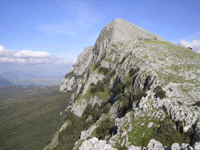Rocca Busambra e Rocche di Roa
|
Site number |
SCI ITA020008 |
|
Administration |
Regione Siciliana |
|
Total area |
6.243 ha |
|
Biogeographical region |
Mediterranean |
| | Website |
| | Standard data form |
| General characteristics |
 There are two contiguous SCIs, but with great differences. One includes the northern slopes (SCI ITA020007 Boschi Ficuzza e Cappelliere, V.ne Cerasa, Castagneti di Mezzojuso) of Rocca Busambra and the other (SCI ITA020008 Rocca Busambra e Rocche di Roa) the southern slopes of the massif (Rocca Busambra) that extends from east to west over 16 km and reaches 1658 m above sea level. In the northern part, woods are predominant, including the best-preserved oak forests of western Sicily, whereas the south is characterized by grasslands with xerophile species. There are two contiguous SCIs, but with great differences. One includes the northern slopes (SCI ITA020007 Boschi Ficuzza e Cappelliere, V.ne Cerasa, Castagneti di Mezzojuso) of Rocca Busambra and the other (SCI ITA020008 Rocca Busambra e Rocche di Roa) the southern slopes of the massif (Rocca Busambra) that extends from east to west over 16 km and reaches 1658 m above sea level. In the northern part, woods are predominant, including the best-preserved oak forests of western Sicily, whereas the south is characterized by grasslands with xerophile species.
|
|
Habitat types and species of major interest |
 The two SCIs, deeply connected are included in the Riserva Naturale Orientata Bosco di Ficuzza and have an overall extent of more than 7000 ha which is characterized by very different climates and, therefore, a great biodiversity hosting almost all plant species present in Sicily and numerous endemic species. Regarding the fauna, this area is the ideal refuge for wildcats - only few are still present on Etna - weasels, hedgehogs, foxes and the majestic golden eagle. The two SCIs, deeply connected are included in the Riserva Naturale Orientata Bosco di Ficuzza and have an overall extent of more than 7000 ha which is characterized by very different climates and, therefore, a great biodiversity hosting almost all plant species present in Sicily and numerous endemic species. Regarding the fauna, this area is the ideal refuge for wildcats - only few are still present on Etna - weasels, hedgehogs, foxes and the majestic golden eagle. |
|
|
Use |
The site has great importance in terms of hiking thanks to the dense network of trails that lead to the woods of holm and cork oaks, as well as cedars. Among the places of interest, there are wetlands along Gorgo Lungo Gorgo Tondo and the peschiera del re, the Gorgo del drago, and the caves of Romito, Acqua ammucciata (hidden), the woodlands of Fanuso and Capreria. The network of trails spread over 120 km, which can be used either by foot, by mountain bike or on horseback. The area includes many historical sites, for example the Real Casina di Caccia di Ficuzza, built in the early 1800s by Ferdinand IV of Bourbon. Together with the Regional Centre for Recovery of Wild Fauna it is a great tourist attraction, assuming a dominant role in the economy of the area. |
Other study sites LIFE+
Making good Natura
